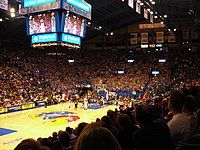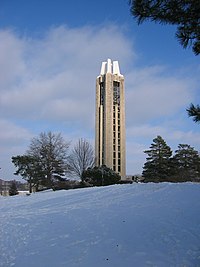University of Kansas
The University of Kansas (also called KU or Kansas ) is a state university in Lawrence in the east of the US state of Kansas . With 28,447 students enrolled in 2017, it is the largest college in Kansas. In addition to the main campus in Lawrence, there is a university hospital in Kansas City, Kansas , a branch in Overland Park (near Kansas City ), research institutes in Parsons and Topeka, and a branch of the medical school in Wichita . The university includes the University of Kansas Natural History Museum and the Helen Foresman Spencer Museum of Art . The university is a member of the Association of American Universities , an association of leading research-intensive North American universities that has existed since 1900.
KU runs a very successful international student exchange program and was awarded the Paul Simon Award for Internationalization in 2005. 20 percent of the students who acquire an advanced degree at KU also studied abroad during their time at KU. More than 1,600 international students from 110 countries study, teach or research at KU. 28 languages are taught. KU is ranked 23rd out of more than 200 major colleges and universities for the number of students who are members of the Peace Corps .
history

The university was founded in 1865 and was the first university in the United States to introduce sociology in 1890 . The KU chemistry professors Hamilton Cady and David McFarland were the first to demonstrate in 1905 that large amounts of helium existed on earth (helium was previously considered to be rare or nonexistent). One of the best-known professors of German origin at KU was the painter Albert Bloch , who had been a member of the German painter group Blauer Reiter for many years in Germany (1908–1921) . From 1923 to 1947 he was Dean ( Department Chair ) of the Institute for Painting and Drawing. The campus radio KJHK has been operated by students since 1952. The current chancellor of the university has been Bernadette Gray-Little since 2009.
On her world tour in 1927, described in the work All Around. Adventure of a world tour , Klaus Mann and his sister Erika visited the University of Kansas, where they gave some lectures.
The university's mascot is the Jayhawk , a non-real bird that is a mixture of two birds of prey, namely a hawk or hawk (English "hawk") and the jay (English "jay"). The mascot refers to the Jayhawkers , militias and guerrilla fighters, or sometimes simply gangs of robbers, who raided Kansas and neighboring states during the Territorial Era (" Bleeding Kansas ") and the war of civil secession and fought against advocates of slavery and supporters of the Confederation .
Course offer
The range of courses includes:
- Architecture and urban design
- Teacher Training for English as a Second Language (TESL)
- Humanities
- Health sciences
- Engineering
- Journalism and mass communication
- art
- medicine
- Molecular Biosciences
- pedagogy
- pharmacy
- Physics and astronomy
- Care (nursing)
- law Sciences
- Social affairs
- Economics
- Social sciences
There is a partnership with Kanagawa University in Yokohama and Hiratsuka (Kanagawa), Japan.
German-American Studies
At the University of Kansas since 1968, a Center for German-American Studies ( Max Kade Center for German American Studies ) at home, from the Max Kade funded Foundation and the Institute for German Studies ( Department of Germanic Languages and Literatures ) care becomes. The institute is home to a library for exile studies and the following projects:
- Atlas for German Dialects in Kansas ( Linguistic Atlas of Kansas German Dialects )
- Digitization of the works of Alexander von Humboldt ( Humboldt Digital Library )
- Research of German-Americans in Kansas after 1848
- the archives of the painter Albert Bloch and the Germanist Ernst Rose
- Special collections on the writers Franz Werfel and Ernst Moritz Arndt and the book illustrator George Salter ( John Spalek Collection )
- Libraries of gymnastics clubs of Lawrence and Milwaukee
- Special collection on the history and literature of Hungary
Sports

The traditional strength of the KU is basketball , which was introduced here by its founder James Naismith at the end of the 19th century . The sports teams of the KU are the Kansas Jayhawks . The university is a member of the Big 12 Conference , a league of 12 universities in the central United States. In 2008, the Kansas Jayhawks were national champions in college basketball for the fifth time (1952 and 1988 in the NCAA college league , before that in 1922 and 1923 in the Helms National Championship ). The football team had the most victories in university history in 2008, winning the Orange Bowl .
Well-known professors
- Eugen Altschul - economist
- Albert Bloch - painter
- Hamilton Cady - chemist
- Fritz Heider - psychologist
- Richard H. Himes - biochemist
- Ida Henrietta Hyde - Physiologist
- Kermit E. Krantz - gynecologist
- Don Marquis - medical ethics
- David McFarland - chemist
- James Naismith - Physical Education
- Joe Paretsky - microbiologist
Well-known graduates
- John L. Allen - journalist
- Philip F. Anschutz - businessman
- Sheila Bair - Chairman of the Federal Deposit Insurance Corporation
- Scott Bakula - actor
- James Bausch - Olympic champion, American football player
- Helen Brewster Owens (1881–1968), mathematician, university teacher, and suffragette
- Cynthia Carroll - CEO of the Anglo American mining company
- Wilt Chamberlain - basketball player who played in the NBA who averaged over 30 points and 25 rebounds
- Linda Cook - Member of the Board of Directors at Royal Dutch Shell and CEO of Shell Gas & Power
- Alfred de Chapeaurouge - German politician, exchange student in the academic year 1931/32
- Bob Dole - Politician (studies interrupted because of World War II and finished at other universities)
- Paul R. Ehrlich - Entomologist
- Joel Embiid - Cameroonian basketball player
- Ronald Ellwin Evans - astronaut
- Mary W. Gray - mathematician and university professor
- Moses Gunn - actor
- William Inge - writer
- Josh Jackson - Basketball player for the Phoenix Suns
- Wes Jackson - biologist
- Don Johnson - actor
- Dusty Johnson - politician
- Sascha Kaun - Russian basketball player
- Neil LaBute - actor
- Alf Landon - former governor of Kansas
- Elmer McCollum - co-discoverer of vitamin A.
- Mike McCormack - American football player and coach
- Alan Mulally - CEO of Ford Motor Company , former CEO of Boeing
- Svyatoslav Mychajljuk - Ukrainian basketball player
- Al Oerter - track and field athlete and four times Olympic champion in discus throw
- Sara Paretsky - writer and historian
- Mandy Patinkin - actor
- Paul Pierce - basketball player
- Paul Rudd - actor
- Adolph Rupp - basketball coach
- Jim Ryun - athlete and politician
- Gale Sayers - American football player
- Otto Schnellbacher - American football player
- Dean Smith - basketball coach
- Vernon L. Smith (MA Economics) - Nobel Prize in Economics 2002
- Walter Sutton - geneticist
- Clyde Tombaugh - astronomer (discoverer of the dwarf planet Pluto )
- Andrew Wiggins - Canadian basketball player
- Lynette Woodard - basketball player
- Gary Woodland - golfer
Individual evidence
- ↑ About KU • The University of Kansas ( English ). Retrieved January 4, 2018.
- ↑ Jayhawk • Traditions • About KU • The University of Kansas ( English ). Retrieved January 4, 2018.
Web links
- The University of Kansas
- Max Kade Institute at the University of Kansas
- Digital Humboldt Library
- Linguistic Atlas of Kansas German Dialects
- Description of the first evidence of helium on earth by KU professors (English)
Coordinates: 38 ° 57 ′ 13 ″ N , 95 ° 15 ′ 36 ″ W.

